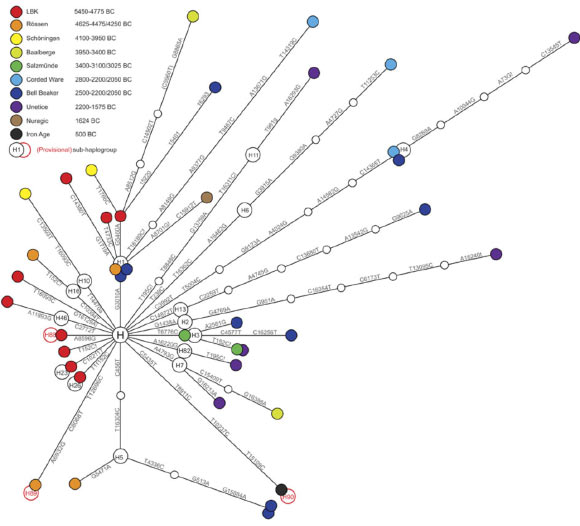An international team of scientists has used ancient DNA recovered from human remains dating from up to 5,500 BC to reconstruct the first detailed genetic history of modern Europe.

This image shows phylogenetic network of 39 prehistoric mitochondrial genomes sorted into two groupings – Early Neolithic, left, and Mid-to-Late Neolithic, right. Node colors represent archaeological cultures. LBK – Linear Pottery Culture (Paul Brotherton et al)
The research reveals a dramatic series of events including major migrations from both Western Europe and Eurasia, and signs of an unexplained genetic turnover about 4,000-5,000 years ago.
The team used DNA extracted from bone and teeth samples from prehistoric human skeletons to sequence a group of maternal genetic lineages that are now carried by up to 45 per cent of Europeans.
“This is the first high-resolution genetic record of these lineages through time, and it is fascinating that we can directly observe both human DNA evolving in ‘real-time’, and the dramatic population changes that have taken place in Europe,” said Dr Wolfgang Haak of the University of Adelaide’s Australian Center for Ancient DNA, co-author of a paper published in the journal Nature Communications.
“We can follow over 4,000 years of prehistory, from the earliest farmers through the early Bronze Age to modern times.”
“The record of this maternally inherited genetic group, called Haplogroup H, shows that the first farmers in Central Europe resulted from a wholesale cultural and genetic input via migration, beginning in Turkey and the Near East where farming originated and arriving in Germany around 7500 years ago,” explained co-author Dr Paul Brotherton of the University of Huddersfield, UK.

Top left: population affinities of Neolithic cultures. Figure based on the frequencies of 15 sub-haplogroups from 37 present-day Western Eurasian and 3 ancient populations: light blue – Western Europe; dark blue – Central and Eastern Europe; orange – Near East, Caucasus and Anatolia; and pink – ancient samples. Populations are abbreviated as follows: GAL, Galicia; CNT, Cantabria; CAT, Catalonia; GAS, Galicia/Asturia; CAN, Cantabria2; POT, Potes; PAS, Pasiegos; VIZ, Vizcaya; GUI, Guipuzcoa; BMI, Basques; IPNE, Iberian Peninsula Northeast; TUR, Turkey; ARM, Armenia; GEO, Georgia; NWC, Northwest Caucasus; DAG, Dagestan; OSS, Ossetia; SYR, Syria; LBN, Lebanon; JOR, Jordan; ARB, Arabian Peninsula; ARE, Arabian Peninsula2; KBK, Karachay-Balkaria; MKD, Macedonia; VUR, Volga-Ural region; FIN, Finland; EST, Estonia; ESV, Eastern Slavs; SVK, Slovakia; FRA, France; BLK, Balkans; DEU, Germany; AUT, Austria, ROU, Romania; FRM, France Normandy; WIS, Western Isles; CZE, Czech Republic; LBK, Linear pottery culture; BBC, Bell Beaker culture; MNE, Middle Neolithic. Top right: procrustes analyses of geographic coordinates and principal component analysis scores of the same data set. Bottom: ward clustering dendrogram of the 3 ancient groups and present-day populations (Paul Brotherton et al)
Co-author Prof Alan Cooper, who is also from the University of Adelaide’s Australian Center for Ancient DNA, said: “what is intriguing is that the genetic markers of this first pan-European culture, which was clearly very successful, were then suddenly replaced around 4,500 years ago, and we don’t know why. Something major happened, and the hunt is now on to find out what that was.”
The team developed new advances in molecular biology to sequence entire mitochondrial genomes from the ancient skeletons. This is the first ancient population study using a large number of mitochondrial genomes.
“We have established that the genetic foundations for modern Europe were only established in the Mid-Neolithic, after this major genetic transition around 4,000 years ago. This genetic diversity was then modified further by a series of incoming and expanding cultures from Iberia and Eastern Europe through the Late Neolithic,” Dr Haak said.
“The expansion of the Bell Beaker culture (named after their pots) appears to have been a key event, emerging in Iberia around 2,800 BC and arriving in Germany several centuries later. This is a very interesting group as they have been linked to the expansion of Celtic languages along the Atlantic coast and into central Europe,” Dr Brotherton said.
Prof Cooper added: “these well-dated ancient genetic sequences provide a unique opportunity to investigate the demographic history of Europe. We can not only estimate population sizes but also accurately determine the evolutionary rate of the sequences, providing a far more accurate timescale of significant events in recent human evolution.”
“This work shows the power of archaeology and ancient DNA working together to reconstruct human evolutionary history through time. We are currently expanding this approach to other transects across Europe,” concluded co-author Prof Kurt Alt from the Johannes Gutenberg University Mainz.
______
Bibliographic information: Paul Brotherton et al. 2013. Neolithic mitochondrial haplogroup H genomes and the genetic origins of Europeans. Nature Communications 4, article number: 1764; doi: 10.1038/ncomms2656







